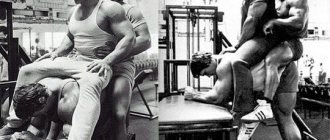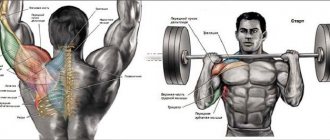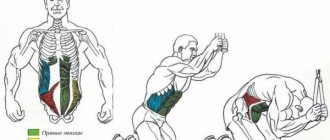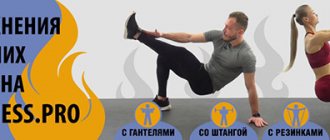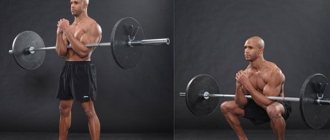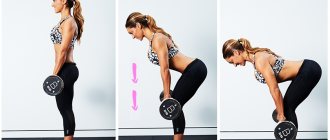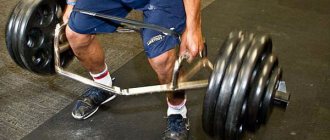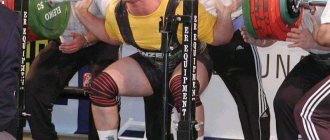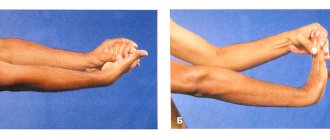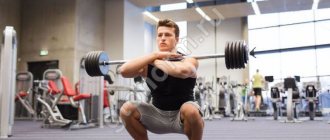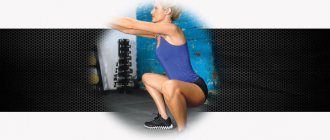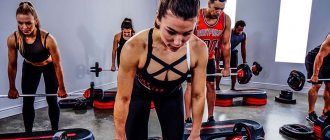This exercise is isolating and specific, that is, the tasks that such training performs are not among the most ambitious.
Sisi squats perform the function of working out the lower part of the quadriceps and adjusting the proportions. In this exercise, light weights are used, or no weights are used at all. Accordingly, you can perform this exercise optionally or as a component of a superset. One way or another, you should not develop a load in this exercise or strive to do the greatest number of repetitions. Consider chest squats as auxiliary ones in order to focus on the lower quadriceps if necessary.
The load is placed on the knee joints, that is, people who have any ailments in this part of the body or whose joints are undeveloped should refrain from doing a significant amount of chest squats.
It’s better to start with your own weight, and if you weigh more than 90 kilograms, then you need to be more careful with the execution, since such a load is enough to load the joint. It is quite possible to vary the training program with these squats, for example, use them as a warm-up before heavy squats with a barbell, or use them to develop coordination and flexibility, or stretch the muscles with them and complete the workout with such an exercise.
Anatomy of movement
When performing sissy squats, the greatest load falls on the quadriceps, namely its lower part. Additionally, the calf muscles, buttocks and back of the thigh work.
Special attention should be paid to the functioning of the joints. The exercise puts increased stress on the knees. At the lowest point of the movement, the knee joints are brought forward much further than the toe line. This position in itself is dangerous. In fact, this is the main drawback of the exercise due to which it is not often used in training programs. For any knee injuries, this type of squats is contraindicated.
If your joints are fine, the exercise should still be performed with caution. The benefits for muscle development should not be outweighed by the risk of injury. Additional weight is either not used or is insignificant. To sufficiently load the lower quadriceps, with such an unusual squat, your own weight is more than enough.
In addition to the knees, the ankle is involved in the movement. This exercise is very useful for developing flexibility and mobility.
Work of muscles and joints
The main load during chest squats is performed by the quadriceps of the thigh, mainly the lower part of the quadriceps, but the calf muscles are also involved. Unlike many other squats, during which the center of gravity is located in the heel and the outer part of the foot, in this case the athlete rests his toes on the floor, with the knee extending well beyond the line of the toes.
Actually, this alone is enough to, from a biomechanical point of view, load the knee joint, therefore, we emphasize once again, the exercise is performed without additional weights. The unusual form of performing these squats forces you to hold on to a wall or some other object, because otherwise you simply will not be able to maintain your balance.
There are two joints: the knee and the ankle, which have their pros and cons. The main disadvantage is the risk of injury and, as a consequence, the inability of chest squats to use additional weights. The advantage is that it is possible to stretch the ankle very well, so the exercise is also performed in order to more easily maintain the center of gravity in the heels while performing classic squats with a barbell.
In this case, by the way, it is also allowed to use small pancakes to place them under the heel, as this will help to perform the exercise easier. In any case, the priority always remains the correct technique of execution and a slow speed of flexion and extension of the knee joint.
Place in training
Overall, sissy squats performed on supported toes are a very unusual exercise. Before including it in your training, think about what problems you plan to solve. The main goal of such squats is precisely the qualitative adjustment of body proportions. This exercise is not suitable for gaining leg mass.
There are two fundamentally different approaches to performing such squats. Some people prefer to use them to warm up before barbell squats. In this case, they act as a warm-up exercise, preparing the muscles for intense exercise. Other athletes take advantage of the fact that toe squats are great for stretching muscles. To take advantage of this, they put them at the end of the session to complete the leg workout.
About the name
Many people are interested in why the exercise has such a strange name. There are two versions. The first says that the position that must be taken in this squat is very similar to the pose of Sisyphus - the ancient Greek martyr doomed to eternal labor in the kingdom of dark Hades. The second point of view connects the term with the vulgar translation of the word “Sissy” - sissy, mama’s boy.
At first glance, it may indeed seem that this exercise is very easy to perform. But this is a misleading impression. Try to do at least one sissy squat - and you will immediately understand why it is strongly recommended to be performed only by well-trained athletes.
Execution technique
The classic version of sissy squats looks like this.
- Stand at a support and grab it with one hand. A wall bars or handrail are perfect. The back should be straight, shoulders straightened.
- Place your feet together or 20-25 cm wide, parallel to each other. When performing the exercise, the body weight should be on the toes, and not on the heels, as in classic squats. For convenience, you can place small pancakes or a wooden block under your heels.
- The exercise is usually performed without weights. But if you feel that you don’t have enough weight, take a dumbbell or a barbell in your free hand. It is better to hold the weight in front of your chest (pancake) or in your arm extended downwards (dumbbell). Work with light weights that will allow you to complete 20-25 repetitions. Such precautions are due to the fact that the exercise is classified as traumatic.
- From the starting position, keeping your back perfectly straight, slowly perform a squat. At the same time, the body leans back, and the knee joints bend until a right angle is reached. Some athletes squat until their knees touch the floor and their heels touch their buttocks. But in this case, the risk of injury increases as much as possible. Whether you need this - decide for yourself. Make sure that your knees do not move to the side, but move straight forward.
- As you exhale, slowly return to the starting position. Do not straighten your knees completely, this will make the movement less traumatic.
- Repeat 20-25 times. Take a break and do 1 more approach.
Some athletes prefer to do this exercise in a special simulator, the so-called hack machine. It allows you to work your quadriceps even more effectively.
Types of sissy squats
After adapting the muscles and mastering the technique, diversify the training.
- Try the same thing in a sissy squat machine or with weights.
- A great option for polishing your quadriceps is to take a plate in your free hand , bring it to your chest, or work while standing on your toes.
- Sissy squats with dumbbells behind your back in straight arms are no less effective. Practicing with weights increases energy consumption by 2 times.
Sources
- https://lifegid.com/bok/3375-chto-takoe-sissi-prisedaniya.html
- https://hudeyko.ru/sissi-prisedaniya.html
- https://mp3hu.ru/?mp3=%D0%A8%D0%BA%D0%BE%D0%BB%D0%B0%20%D0%B4%D0%BB%D1%8F%20SISSY%20BOYS
- https://FitNavigator.ru/baza-uprazhnenij/sissi-prisedanija.html
- https://bodybuilding-and-fitness.ru/zanyatiya-sportom-dlya-nachinayushih/bodibilding-uprazhneniya/sissi-prisedaniya.html
[collapse]
Common Mistakes
The supported squats described above may seem like a fairly simple exercise, but they are not. To minimize the likelihood of injury and maximize stress on your quadriceps, use the following tips.
- Avoid sudden movements and use of inertia. Squat as slowly as possible, holding on to the support.
- It is better to refuse weights until you have fully mastered the technique.
- It makes sense to perform the exercise in the middle of a complex workout or at the end of a block of exercises for the leg muscles. If you decide to start a class with sissy squats, be sure to warm up your knee joints. A few minutes of warm-up exercises will protect you from injury.
- Your body will develop harmoniously if you add aerobic exercise to your training plan. If your goal is legs, a bicycle is perfect for you.
- Do as many repetitions as possible. The approach can be completed when a strong burning sensation appears in the muscles.
- If you feel pain or discomfort in your knee joint during an exercise, stop. You might want to replace sissy squats with another safer exercise.
Performing sissy squats will help those who want to achieve ideal shape and definition of their quadriceps. Unlike regular dumbbell or barbell squats, they do not particularly increase the size and muscle mass of the thighs. For the best effect, such squats should be combined with other leg exercises as part of supersets.
Sisi squats - diagram
Perform the exercise before leg training or leave it for the finale for high-quality work on small muscles and stretching of fibers.
- Grasp the vertical support with one hand. A Swedish wall, a power rack, and even a fitball are suitable for this purpose. Place the gymnastic ball against the wall, put your legs forward and create support for your back.
- Place your feet at a distance of 30 cm. Since the body weight shifts onto your toes during work, place thin blocks under your heels for comfort.
- Straighten your body, bend your knees and move your upper body back.
- Continuing to bend your legs, smoothly bring them forward and lower yourself down until a right angle is formed at the joints. If the muscles are well trained, lower your pelvis deeper. Track the direction vector of the knees. They should be under your feet. After all, the point of the exercise comes down to keeping the neck, back and pelvis on the same line.
- Pause for a moment and immediately rise, avoiding inertial movements.
Ideally, perform sissy squats with your own weight until your muscles burn, trying to reproduce the extra movement in the next workout.
1) Stand near a wall or wall bars so that it is convenient for you to hold on to the support while doing the exercise. 2) Place your feet narrower than your shoulders, you can even press your toes and heels to each other, but the knee and toe should always point in the same direction, in this case forward. 3) Arch your back at the waist, push your chest forward and lift your head to maintain correct posture throughout the entire range of motion.
1) The exercise should be performed using muscle effort, and not due to mechanical inertia, so the speed of doing squats should be slow. 2) The breathing technique is normal: inhale in the negative phase, exhale with effort. 3) If chest squats are the first exercise for workout, then before performing them you should warm up your knee joints.
Anatomy
The quadriceps is one of the largest muscles in the human body and consists of as many as four heads, so it needs to be trained a lot and variedly. Sisi squats allow you to specifically load that part of the quadriceps that is usually underused, and besides, the load that this exercise accumulates is unusual.
Due to the fact that an unusual load also creates unusual stress, despite the absence of additional weights, such specific squats can help break through stagnation in the growth of muscle mass in the legs, or help correct the proportions of the quadriceps heads. At the same time, the exercise is not basic, so it’s up to you to decide whether to use it or not in your training.
To summarize, we can say that chest squats are designed to solve specific problems and are not suitable for all athletes, but in certain conditions they can be very effective. The exercise should be performed at a slow pace, without weights, qualitatively feeling the contraction of muscle fibers.
The technique of performing the exercise is quite unusual, but it must be followed exactly, otherwise you may injure the knee joint. If your knees don't bother you, then you can perform these squats before a heavy leg workout to warm up your knees and, accordingly, prevent injury. We won’t recommend using this exercise, but it’s worth a try!
Exercises for the gym
Benefits of exercise
Despite the fact that sissy squats are not the main exercise for developing leg muscles, many professionals and amateur athletes of different levels still include them in a comprehensive workout.
Find out the benefits of squats for the body of men and women, and also familiarize yourself with the basic techniques and rules of squats.
Working with minimal weight (and often only with your own), such squats contribute to:
- thorough and effective warm-up of the legs before working with heavy weights, including before lifting the barbell;
- correction of the shape and proportions of the legs;
- formation of ideal leg relief;
- reduction of fat deposits in the lower limbs, as well as the knee joint and hips;
- strengthening the muscles of the spine, pelvis, hips;
- endurance training;
- improving joint flexibility;
- working out the ankle joint, which quite often has an overall positive effect on the athlete’s muscles after performing basic exercises;
- involving in the work those muscles that often work passively;
- achieving the necessary athletic tone before lifting heavy weights (at the beginning of training).
Did you know? The owner of the most muscular legs in the world, American bodybuilder Tom Platz, is one of the main fans and popularizers of sissy squats among athletes around the world.
